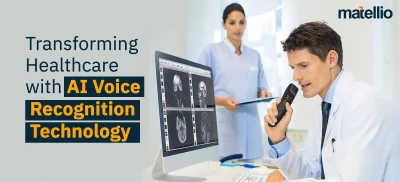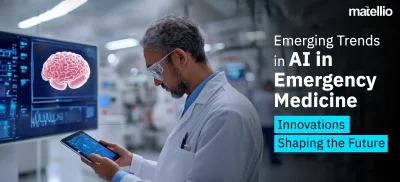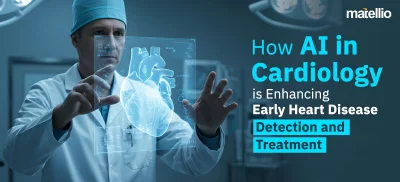
Among all the crucial industries, healthcare remains the most complex and loaded with various opportunities. In the last couple of years, the healthcare industry has been facing a tsunami of challenges due to the COVID-19 outbreak. The hospitals are operating at total capacity, and still, various patients are being treated at their homes with needed attention. In this scenario, every patient cannot get the desired medical attention they need. That’s where remote patient monitoring software comes into the picture.
The worldwide pandemic has paved the way for various new ideas to help doctors in remote patient monitoring. Actually, it has got an upside to it. Monitoring the patient in the hospitals always runs the risk of getting infected multiple times. In simple terms, the infection rates are pretty high in various hospitals. The development of patient monitoring software helps manage the health conditions of numerous patients suffering from various diseases with digital technologies. It helps monitor the conditions of the patient, but it also maintains the vital health records of that particular patient.
In present times, the majority of the hospitals worldwide, with the availability of high-level infrastructure, are developing their own remote patient monitoring software. Such software is the need of the hour as there are various age groups of patients, such as old age patients, unstable patients, etc., that need constant monitoring. Doctors are at ease now with the development of these revolutionary software solutions as they can deliver extra care to each of their patients without any hassle.
As per a report of Statista, more than 85% of the hospitals in the USA have switched to these remote patient monitoring systems. The Healthcare sector is the domain that has the highest numbers of revenue generation as compared to any other domain. If you are thinking of developing such software, you are heading in the right direction. These apps have a high number of downloads and a competitive ROI. In this blog, you will learn the features and development process to consider while creating an effective patient monitoring software.
What’s a Remote Patient Monitoring Software and Its Types?
A remote patient monitoring system is often abbreviated as RPM. It can be defined as a method of healthcare delivery that collects the patient’s vital data and delivers the needed consultations or care with the use of advancements of the information technology available. This process completely rules out the traditional healthcare techniques. In laymen’s terms, this process allows the delivery of healthcare in the patients’ homes where they live, work or enjoy their daily routines.
These systems don’t rely on wire-laden medical devices, but they operate on today’s sleek, user-friendly personal tech products such as smartphones, tablets, etc. These personal devices are straightforward to use and are owned by every person regardless of his/her age. These remote patient monitoring systems make the most out of the available technology, and the users feel highly comfortable in getting the desired care they need remotely. It’s not only the patients that benefit from these systems, but the doctors also find it helpful in understanding and managing their patients’ health conditions with the help of a coherent stream of data that draws a clearer image of the patient’s health.
In the last year, remote patient monitoring software has grown by 10 percent, and it has been predicted that this industry will grow at the rate of 27% to 32% in the coming couple of years. Not only the software but the apps associated with this domain are being utilized to deliver quality treatments for patients suffering from acute conditions and chronic diseases. The current revenue generation of this sector is about 119 million US dollars, and it is expected to increase by more than 1.5 billion US dollars in the next four years. Even after the pandemic is gone, these softwares will continue to grow and become a long-term prospect.
Also Read – Future of Wearable Devices in the Healthcare Sector
Types of Remote Patient Monitoring Softwares
The primary intent of these softwares is to connect the doctors and patients to exchange the desired consultations, prescriptions, and treatments remotely. The market is brimming with these types of softwares that have various operating platforms and technologies.
1. Telehealth Software: This software is the most common one as its functionality is effortless. They connect the patient to the doctors over video calls to have their medical examination done, and for writing consultations, doctors do the same. These platforms have encryption-based video calls. Hence, all the data shared over this platform is actually very secure.
Read More: Develop a Telehealth App Like Healow to revolutionize patient care with seamless virtual consultations and efficient health management.
2. IoT Medical Applications: With the developments of AI devices that are commonly called the internet of things are a step ahead of all the available remote patient monitoring systems. They can be in the form of wearables and monitor all the patient’s vital data for a record such as blood pressure, heart rate, sugar level, etc.
They use health care trackers and intelligent sensors to the essential data precisely. This data is then transferred to the assigned doctors and follows the course of treatment based on this data.
Read More: Explore how AI in Remote Patient Monitoring Services enhances real-time healthcare insights and improves patient outcomes.
3. Precise Medical Solution: This patient monitoring software is not like other RPMs, but it helps the doctors and researchers to collect the essential data from patients that have volunteered to do so for research purposes only. These patients are the ones that have developed unique symptoms of a particular disease throughout their treatments.
4. Questionnaires-based software: This software operates on a survey format that asks the patients a set of questions based on the disease they are suffering from. It is the most common form of digital treatment available out there. The doctors ask a set of questions to the patients about their symptoms and conditions, and the users have to answer them; based on the results of these questions, doctors start the treatment.
Also Read : What is Hospital Management System and Why You Need One?
Critical Components of Remote Patient Monitoring Software
Several vital components should be present in any remote patient monitoring system, but some of these components are mandatory. These components help enhance the functionality of these systems and the doctors associated with this platform to understand their patients’ health conditions and act accordingly. In an ideal scenario, these four components are a must-have:
-
Patient Mobile App
Patients should have a mobile app associated with this kind of system. This mobile app serves them in various ways. They can upload their previous prescriptions, update their current condition, book appointments with a doctor, order medicines, and monitors their vital signs. This particular app should have some enhanced features that enable them to perform all the mentioned operations such as uploading the documents, personal profile, payment gateway for easy payments, location integration, etc.
-
Personal Medical Device with a Bluetooth Module
A personal device with a Bluetooth module helps these systems in various ways. Any smart wearables can’t measure some parameters. Hence, these devices come to help. Users can connect these devices to their apps and record all the essential data required for their doctors to treat them better. These remote monitoring systems consist of medical devices such as electronic thermometers, electrocardiographs (ECGs), electroencephalographs (EEGs), cardiac monitors, apnea monitors, spirometers, oximeters, audiometers, blood pressure monitors, breathing frequency monitors, and electronic stethoscopes.
-
Cloud Repository
Cloud storage is needed as these remote monitoring systems generate a massive load of data in the form of prescriptions, health records, medicines receipts, etc. This kind of data is susceptible and requires safe and secure cloud storage. When treating a patient with chronic disease, their files can be heavy in terms of data size as they would require a large section of past medical records. Apart from this, there will be a series of documents of medicine or drug invoices. A patient or their doctors could use this storage to access any required document anywhere, anytime.
-
Hospital-side software
The hospital that will monitor a particular patient will need a software to ensure seamless healthcare delivery. This software will allow them to manage several tasks on their end, such as a list of doctors to be assigned, patients’ current vital data, patient dues, patient’s device status, etc. This software will serve the purpose of overall remote monitoring. This software will behave as their back-end architecture. The hospital can send reminders to the patients regarding their routine check-ups, medication time, connect with the doctors, etc.
-
Development Process
Creating a patient monitoring software requires a lot of research and planning. If you have decided to enter this domain, you should be prepared for the challenges ahead. There are several most popular RPM systems available in the market. To make a name out of your project, you should know everything about the market’s current trends. Analyze your competitors and their operation structure.
Your project should deliver better and enhanced healthcare monitoring as compared to the pre-existing systems. You can try implementing some advanced features that will ease the process for both the patient and the doctors. Brainstorm ideas with your team and create a roadmap to proceed further. You will need the assistance of a software development company that knows in and out of the health care industry.
Also Read: Discover how AI Billing Software is revolutionizing healthcare finance, helping hospitals and clinics save millions through automated processes, reduced errors, and improved revenue management.
Technologies to Consider
Developing any RPM solution facilitates an effective workflow of healthcare services, enhances the doctor’s collaboration, and allows professionals to monetize their contributions. There are various factors to consider while developing such platforms. You have to integrate a video conferencing app plugin, various existing third-party services. You can always embed the video chat or a text chat feature in your software.
-
API’s
Various APIs perform various functions, and you have to identify the one that aligns with your domain. Their list of APIs includes Medicine and drug data API, Symptom checker API, Drug interaction checker API, Health data API, Patient360 API, Diagnostic Network API, eFax API, Natural Language Processing API, Identity Verification API, FHIR Store API, etc.
-
Languages and Frameworks
Programming languages and frameworks help you carving the desired back-end and front-end architecture of your software. Your developer can choose the programming based on their functionalities. For back-end architecture, you can use programming languages such as Node.Js, R language, SQL, Java, Python, ASP.NET, etc.
Your software should follow all the security guidelines associated with remote patient monitoring, such as SOC2 Type2, ISO27001, etc. Every connection should start with HTTPS: To enhance security, you can always enable two-factor authentications.
For the purpose of front-end development, you can consider Java, Swift, HTML, Kotlin, etc. Remember to make the front-end section of your software attractive and easy to use. Patients love the ease of access. Everything should be discoverable on your software, and they don’t have to face any difficulty finding any icon or feature.
-
Cost Involve
Capital invested in any project is a variable quantity. There is no such calculation available out there that can get you an exact amount for your software development. Only software or app development can get you the proper approximation of the cost for your desired product.
Various factors can affect the cost of development such as, the number of platforms on which you want to launch your software, number of features to be embedded, APIs to be integrated, number of third-party services, hiring a team of freelancers, or a software or mobile app development company, etc.
The primary factor to affect the cost of development is your developing partner. Before hiring any firm, always check their background, experience, and ratings. With the proper feedback, you can easily decide which firm will deliver you the project of your expectations. Any development associated with such projects will consist of a UI/UX designer, developers, a software testing engineer, and a project manager that will oversee the development process.
Also Read: Discover how AI in Pediatric Healthcare is transforming child-centric medical services with custom AI solutions, enhancing diagnostics, treatment, and patient care.
Wrapping Up
Health experts suggest that the use of these remote patient monitoring software will increase in the coming future. Medical researchers are another beneficiary of these projects. These systems allow the doctors to attend to more patients in a day, and the patients get the needed medical attention at the comfort of their home. This industry has a promising future with a pool of opportunities. Remote monitoring systems are paving the path for a completely remote health care industry.
If you have an idea of developing software or an app for remote patient monitoring, Matellio can help. Our proficient developers are aware of every minute detail of the remote healthcare monitoring industry. We have developed several projects of this domain that are successfully operating in the market with outstanding feedback. Fill the contact form for a consultation.




